International Strategies for Smaller Firms: A Detailed Analysis
VerifiedAdded on 2023/01/10
|5
|1228
|43
Report
AI Summary
This report analyzes international strategies for Small and Medium Enterprises (SMEs), focusing on market entry and growth in the global arena. It examines strategies such as niche marketing and forming alliances with larger companies, highlighting their benefits and implementation. The report also discusses the tipping points for SMEs to expand internationally, considering the challenges of domestic regulations, compliance, and the need for economic investment. Furthermore, it explores the significance of the internet in international market expansion for SMEs, emphasizing its role in product promotion, market reach, and cost-effectiveness, while also acknowledging impediments like virtual immaturity and technological dependencies. The report draws on relevant academic references to support its arguments and provide a comprehensive overview of the topic, offering valuable insights for SMEs seeking to grow their businesses internationally.
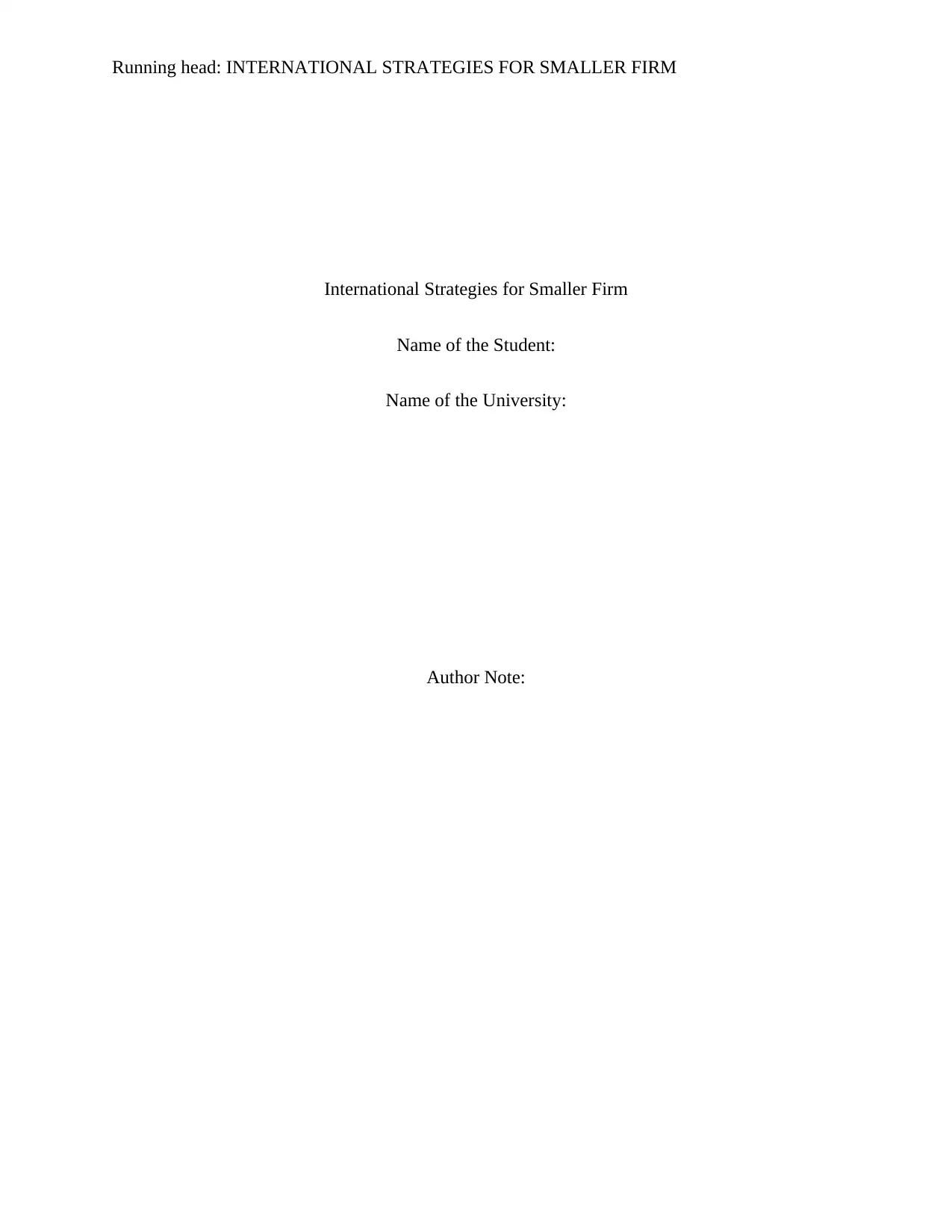
Running head: INTERNATIONAL STRATEGIES FOR SMALLER FIRM
International Strategies for Smaller Firm
Name of the Student:
Name of the University:
Author Note:
International Strategies for Smaller Firm
Name of the Student:
Name of the University:
Author Note:
Paraphrase This Document
Need a fresh take? Get an instant paraphrase of this document with our AI Paraphraser
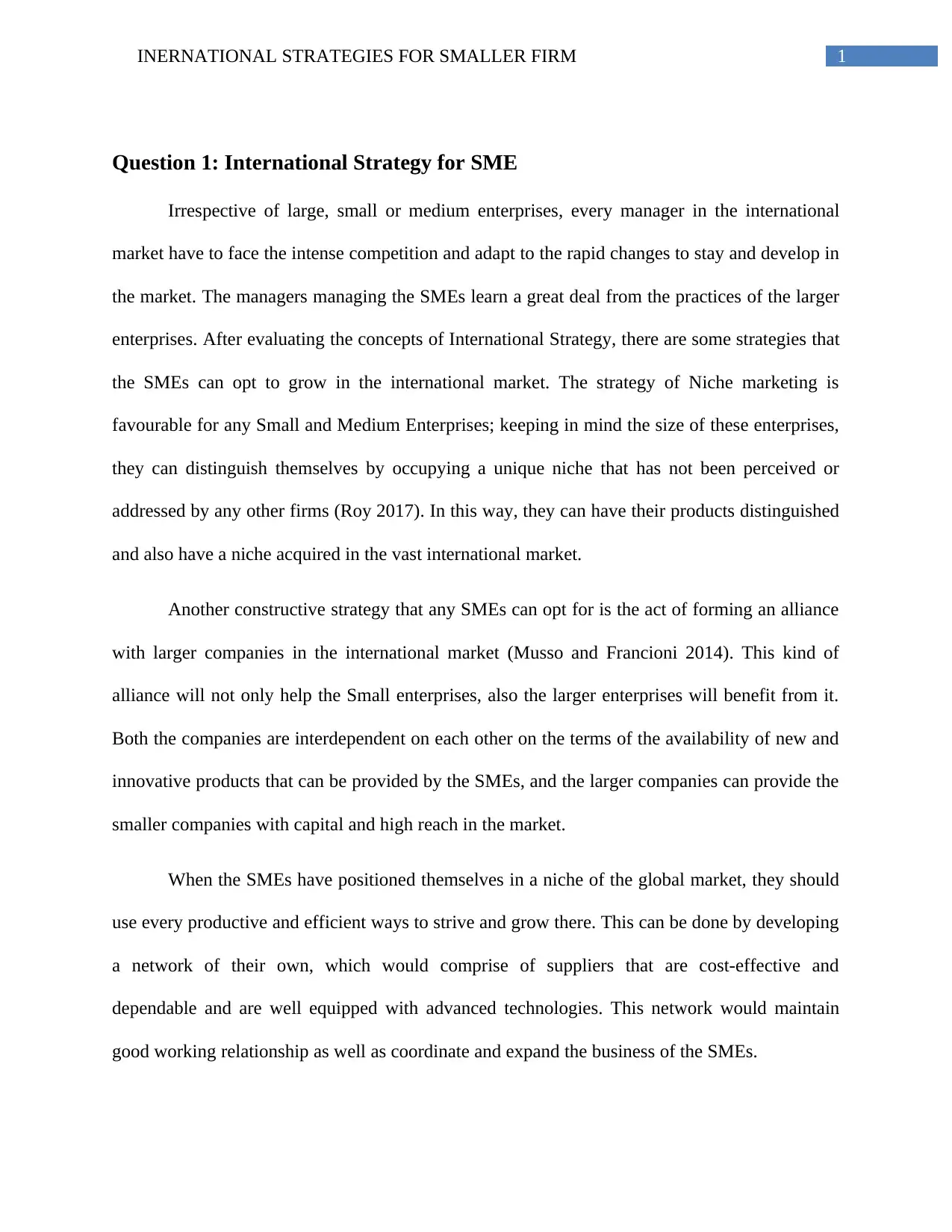
1INERNATIONAL STRATEGIES FOR SMALLER FIRM
Question 1: International Strategy for SME
Irrespective of large, small or medium enterprises, every manager in the international
market have to face the intense competition and adapt to the rapid changes to stay and develop in
the market. The managers managing the SMEs learn a great deal from the practices of the larger
enterprises. After evaluating the concepts of International Strategy, there are some strategies that
the SMEs can opt to grow in the international market. The strategy of Niche marketing is
favourable for any Small and Medium Enterprises; keeping in mind the size of these enterprises,
they can distinguish themselves by occupying a unique niche that has not been perceived or
addressed by any other firms (Roy 2017). In this way, they can have their products distinguished
and also have a niche acquired in the vast international market.
Another constructive strategy that any SMEs can opt for is the act of forming an alliance
with larger companies in the international market (Musso and Francioni 2014). This kind of
alliance will not only help the Small enterprises, also the larger enterprises will benefit from it.
Both the companies are interdependent on each other on the terms of the availability of new and
innovative products that can be provided by the SMEs, and the larger companies can provide the
smaller companies with capital and high reach in the market.
When the SMEs have positioned themselves in a niche of the global market, they should
use every productive and efficient ways to strive and grow there. This can be done by developing
a network of their own, which would comprise of suppliers that are cost-effective and
dependable and are well equipped with advanced technologies. This network would maintain
good working relationship as well as coordinate and expand the business of the SMEs.
Question 1: International Strategy for SME
Irrespective of large, small or medium enterprises, every manager in the international
market have to face the intense competition and adapt to the rapid changes to stay and develop in
the market. The managers managing the SMEs learn a great deal from the practices of the larger
enterprises. After evaluating the concepts of International Strategy, there are some strategies that
the SMEs can opt to grow in the international market. The strategy of Niche marketing is
favourable for any Small and Medium Enterprises; keeping in mind the size of these enterprises,
they can distinguish themselves by occupying a unique niche that has not been perceived or
addressed by any other firms (Roy 2017). In this way, they can have their products distinguished
and also have a niche acquired in the vast international market.
Another constructive strategy that any SMEs can opt for is the act of forming an alliance
with larger companies in the international market (Musso and Francioni 2014). This kind of
alliance will not only help the Small enterprises, also the larger enterprises will benefit from it.
Both the companies are interdependent on each other on the terms of the availability of new and
innovative products that can be provided by the SMEs, and the larger companies can provide the
smaller companies with capital and high reach in the market.
When the SMEs have positioned themselves in a niche of the global market, they should
use every productive and efficient ways to strive and grow there. This can be done by developing
a network of their own, which would comprise of suppliers that are cost-effective and
dependable and are well equipped with advanced technologies. This network would maintain
good working relationship as well as coordinate and expand the business of the SMEs.
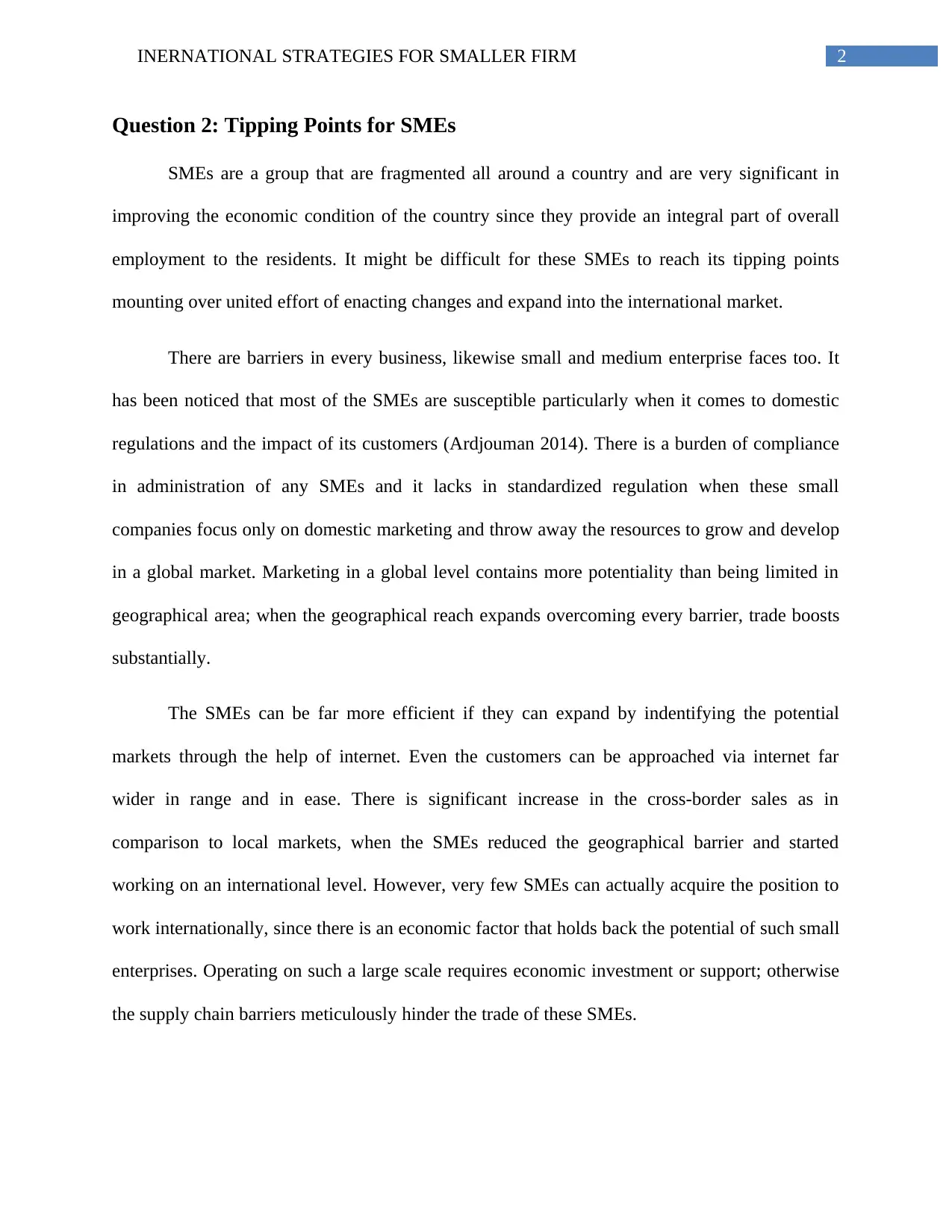
2INERNATIONAL STRATEGIES FOR SMALLER FIRM
Question 2: Tipping Points for SMEs
SMEs are a group that are fragmented all around a country and are very significant in
improving the economic condition of the country since they provide an integral part of overall
employment to the residents. It might be difficult for these SMEs to reach its tipping points
mounting over united effort of enacting changes and expand into the international market.
There are barriers in every business, likewise small and medium enterprise faces too. It
has been noticed that most of the SMEs are susceptible particularly when it comes to domestic
regulations and the impact of its customers (Ardjouman 2014). There is a burden of compliance
in administration of any SMEs and it lacks in standardized regulation when these small
companies focus only on domestic marketing and throw away the resources to grow and develop
in a global market. Marketing in a global level contains more potentiality than being limited in
geographical area; when the geographical reach expands overcoming every barrier, trade boosts
substantially.
The SMEs can be far more efficient if they can expand by indentifying the potential
markets through the help of internet. Even the customers can be approached via internet far
wider in range and in ease. There is significant increase in the cross-border sales as in
comparison to local markets, when the SMEs reduced the geographical barrier and started
working on an international level. However, very few SMEs can actually acquire the position to
work internationally, since there is an economic factor that holds back the potential of such small
enterprises. Operating on such a large scale requires economic investment or support; otherwise
the supply chain barriers meticulously hinder the trade of these SMEs.
Question 2: Tipping Points for SMEs
SMEs are a group that are fragmented all around a country and are very significant in
improving the economic condition of the country since they provide an integral part of overall
employment to the residents. It might be difficult for these SMEs to reach its tipping points
mounting over united effort of enacting changes and expand into the international market.
There are barriers in every business, likewise small and medium enterprise faces too. It
has been noticed that most of the SMEs are susceptible particularly when it comes to domestic
regulations and the impact of its customers (Ardjouman 2014). There is a burden of compliance
in administration of any SMEs and it lacks in standardized regulation when these small
companies focus only on domestic marketing and throw away the resources to grow and develop
in a global market. Marketing in a global level contains more potentiality than being limited in
geographical area; when the geographical reach expands overcoming every barrier, trade boosts
substantially.
The SMEs can be far more efficient if they can expand by indentifying the potential
markets through the help of internet. Even the customers can be approached via internet far
wider in range and in ease. There is significant increase in the cross-border sales as in
comparison to local markets, when the SMEs reduced the geographical barrier and started
working on an international level. However, very few SMEs can actually acquire the position to
work internationally, since there is an economic factor that holds back the potential of such small
enterprises. Operating on such a large scale requires economic investment or support; otherwise
the supply chain barriers meticulously hinder the trade of these SMEs.
⊘ This is a preview!⊘
Do you want full access?
Subscribe today to unlock all pages.

Trusted by 1+ million students worldwide
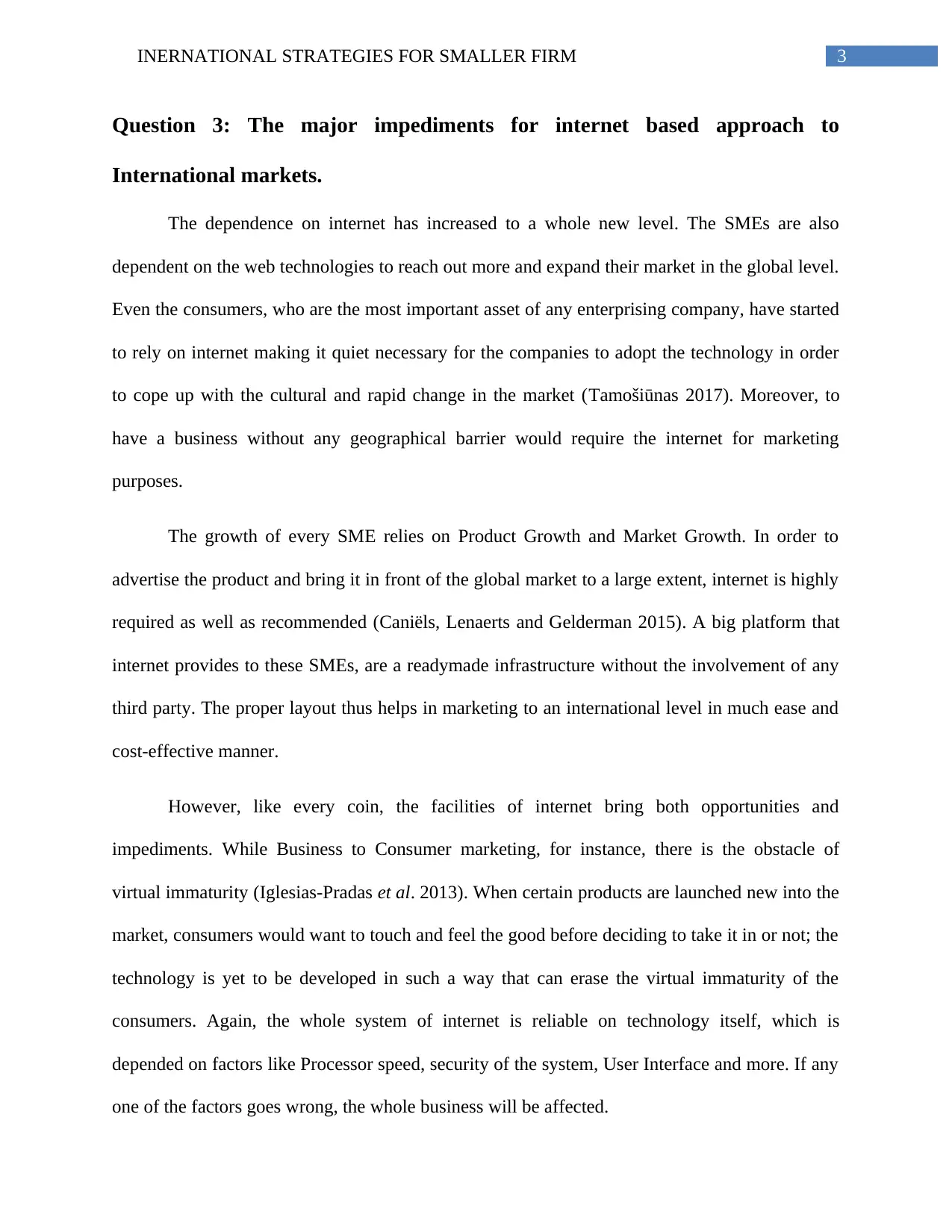
3INERNATIONAL STRATEGIES FOR SMALLER FIRM
Question 3: The major impediments for internet based approach to
International markets.
The dependence on internet has increased to a whole new level. The SMEs are also
dependent on the web technologies to reach out more and expand their market in the global level.
Even the consumers, who are the most important asset of any enterprising company, have started
to rely on internet making it quiet necessary for the companies to adopt the technology in order
to cope up with the cultural and rapid change in the market (Tamošiūnas 2017). Moreover, to
have a business without any geographical barrier would require the internet for marketing
purposes.
The growth of every SME relies on Product Growth and Market Growth. In order to
advertise the product and bring it in front of the global market to a large extent, internet is highly
required as well as recommended (Caniëls, Lenaerts and Gelderman 2015). A big platform that
internet provides to these SMEs, are a readymade infrastructure without the involvement of any
third party. The proper layout thus helps in marketing to an international level in much ease and
cost-effective manner.
However, like every coin, the facilities of internet bring both opportunities and
impediments. While Business to Consumer marketing, for instance, there is the obstacle of
virtual immaturity (Iglesias-Pradas et al. 2013). When certain products are launched new into the
market, consumers would want to touch and feel the good before deciding to take it in or not; the
technology is yet to be developed in such a way that can erase the virtual immaturity of the
consumers. Again, the whole system of internet is reliable on technology itself, which is
depended on factors like Processor speed, security of the system, User Interface and more. If any
one of the factors goes wrong, the whole business will be affected.
Question 3: The major impediments for internet based approach to
International markets.
The dependence on internet has increased to a whole new level. The SMEs are also
dependent on the web technologies to reach out more and expand their market in the global level.
Even the consumers, who are the most important asset of any enterprising company, have started
to rely on internet making it quiet necessary for the companies to adopt the technology in order
to cope up with the cultural and rapid change in the market (Tamošiūnas 2017). Moreover, to
have a business without any geographical barrier would require the internet for marketing
purposes.
The growth of every SME relies on Product Growth and Market Growth. In order to
advertise the product and bring it in front of the global market to a large extent, internet is highly
required as well as recommended (Caniëls, Lenaerts and Gelderman 2015). A big platform that
internet provides to these SMEs, are a readymade infrastructure without the involvement of any
third party. The proper layout thus helps in marketing to an international level in much ease and
cost-effective manner.
However, like every coin, the facilities of internet bring both opportunities and
impediments. While Business to Consumer marketing, for instance, there is the obstacle of
virtual immaturity (Iglesias-Pradas et al. 2013). When certain products are launched new into the
market, consumers would want to touch and feel the good before deciding to take it in or not; the
technology is yet to be developed in such a way that can erase the virtual immaturity of the
consumers. Again, the whole system of internet is reliable on technology itself, which is
depended on factors like Processor speed, security of the system, User Interface and more. If any
one of the factors goes wrong, the whole business will be affected.
Paraphrase This Document
Need a fresh take? Get an instant paraphrase of this document with our AI Paraphraser
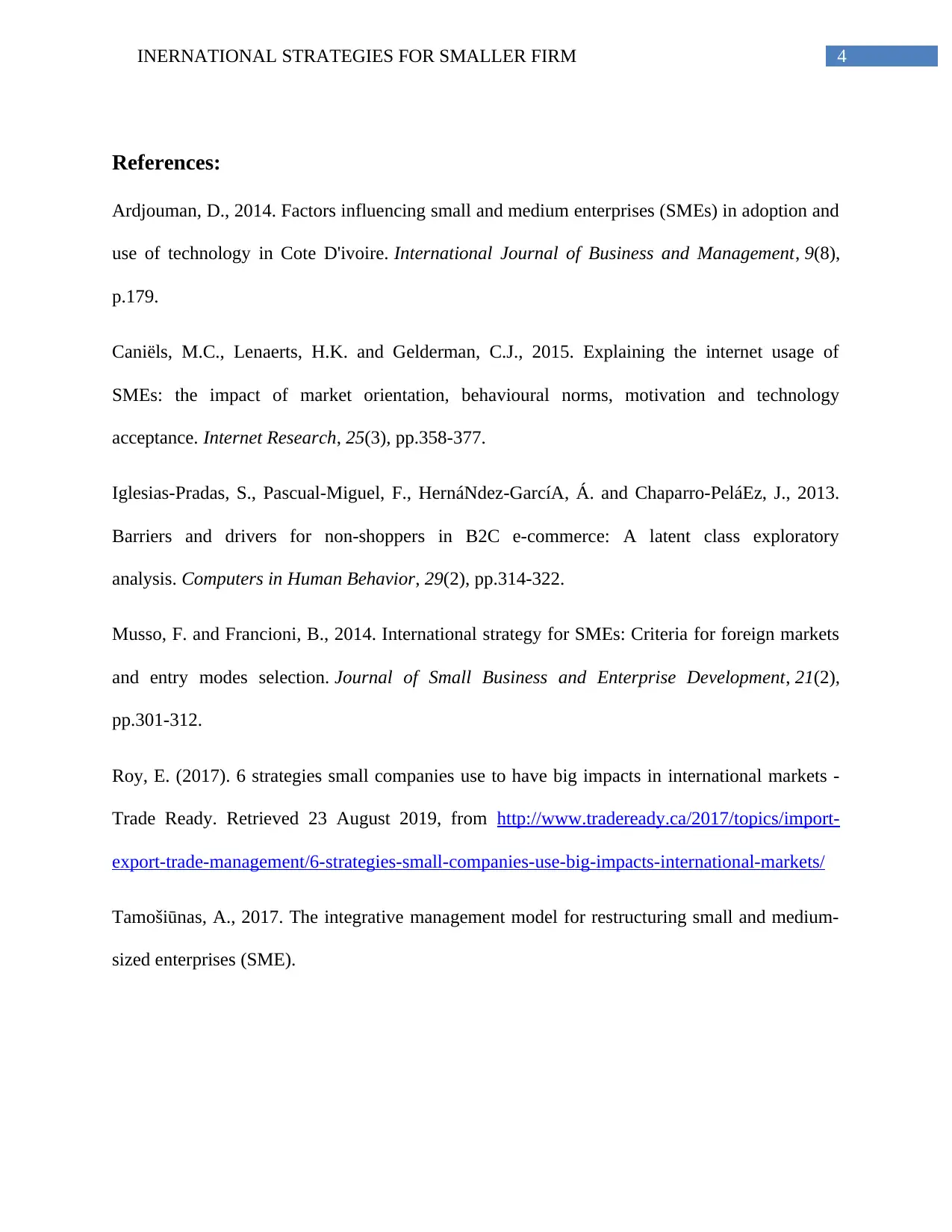
4INERNATIONAL STRATEGIES FOR SMALLER FIRM
References:
Ardjouman, D., 2014. Factors influencing small and medium enterprises (SMEs) in adoption and
use of technology in Cote D'ivoire. International Journal of Business and Management, 9(8),
p.179.
Caniëls, M.C., Lenaerts, H.K. and Gelderman, C.J., 2015. Explaining the internet usage of
SMEs: the impact of market orientation, behavioural norms, motivation and technology
acceptance. Internet Research, 25(3), pp.358-377.
Iglesias-Pradas, S., Pascual-Miguel, F., HernáNdez-GarcíA, Á. and Chaparro-PeláEz, J., 2013.
Barriers and drivers for non-shoppers in B2C e-commerce: A latent class exploratory
analysis. Computers in Human Behavior, 29(2), pp.314-322.
Musso, F. and Francioni, B., 2014. International strategy for SMEs: Criteria for foreign markets
and entry modes selection. Journal of Small Business and Enterprise Development, 21(2),
pp.301-312.
Roy, E. (2017). 6 strategies small companies use to have big impacts in international markets -
Trade Ready. Retrieved 23 August 2019, from http://www.tradeready.ca/2017/topics/import-
export-trade-management/6-strategies-small-companies-use-big-impacts-international-markets/
Tamošiūnas, A., 2017. The integrative management model for restructuring small and medium-
sized enterprises (SME).
References:
Ardjouman, D., 2014. Factors influencing small and medium enterprises (SMEs) in adoption and
use of technology in Cote D'ivoire. International Journal of Business and Management, 9(8),
p.179.
Caniëls, M.C., Lenaerts, H.K. and Gelderman, C.J., 2015. Explaining the internet usage of
SMEs: the impact of market orientation, behavioural norms, motivation and technology
acceptance. Internet Research, 25(3), pp.358-377.
Iglesias-Pradas, S., Pascual-Miguel, F., HernáNdez-GarcíA, Á. and Chaparro-PeláEz, J., 2013.
Barriers and drivers for non-shoppers in B2C e-commerce: A latent class exploratory
analysis. Computers in Human Behavior, 29(2), pp.314-322.
Musso, F. and Francioni, B., 2014. International strategy for SMEs: Criteria for foreign markets
and entry modes selection. Journal of Small Business and Enterprise Development, 21(2),
pp.301-312.
Roy, E. (2017). 6 strategies small companies use to have big impacts in international markets -
Trade Ready. Retrieved 23 August 2019, from http://www.tradeready.ca/2017/topics/import-
export-trade-management/6-strategies-small-companies-use-big-impacts-international-markets/
Tamošiūnas, A., 2017. The integrative management model for restructuring small and medium-
sized enterprises (SME).
1 out of 5
Related Documents
Your All-in-One AI-Powered Toolkit for Academic Success.
+13062052269
info@desklib.com
Available 24*7 on WhatsApp / Email
![[object Object]](/_next/static/media/star-bottom.7253800d.svg)
Unlock your academic potential
Copyright © 2020–2025 A2Z Services. All Rights Reserved. Developed and managed by ZUCOL.





